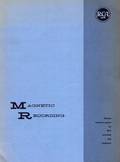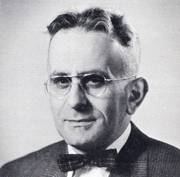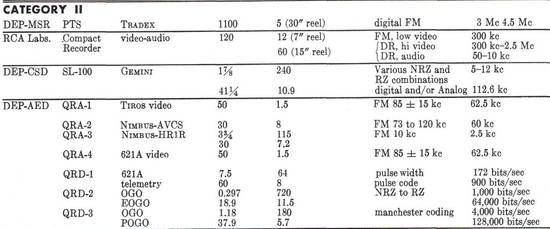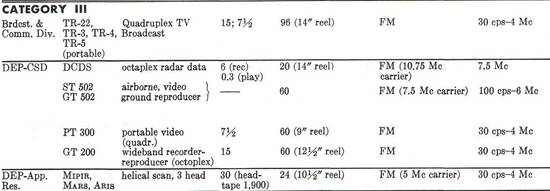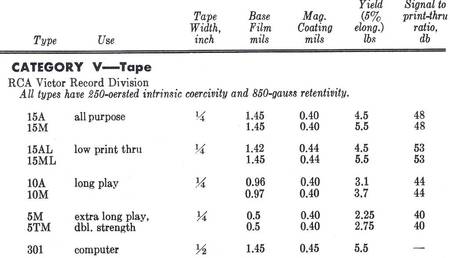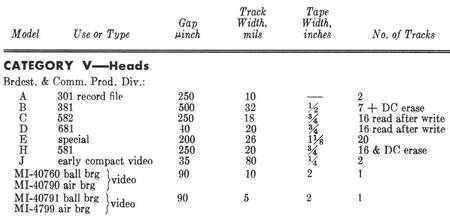13 articles about "Magnetic Recording" - RCA (1964)
ENGINEERING TAPE PRODUCTS AND SYSTEMS 1964 - A COMPANY-WIDE PROGRAM
The importance of magnetic tape devices and systems to RCA's product line and the need to apply the full resources of our research, development, and product-design organizations to the technical problems of these machines led to a corporate-wide "Tape Systems Symposium" in early 1962.
.
H. KIHN, Staff Engineer
Research and Engineering, Princeton, N. J.
HARRY KIHN received his BSEE from The Cooper Union Institute of Technology in 1934, and his MS from the University of Pennsylvania in 1952. Mr. Kihn Joined RCA in 1939 as a research engineer associated with television receiver and circuitry development. During World War II, as a member of the technical staff of RCA Laboratories at Princeton, he performed research relating to radar for automatic bombing and altimeters. With the advent of color television development in the postwar period, he played a prominent part In the development of receiver circuitry. Subsequently he was engaged in further radar reaseach and directed research in pulse code and digital communication and computer systems. Since early I960, he has been a Staff Engineer on the RCA Research and Engineering Staff, in charge of coordinating RCA technical activities in data processing, semiconductor devices, and other fields, including both defense and commercial applications. He is a Fellow of the IEEE, and is a Member of Sigma XI.
.
Über die RCA-Produkte von 1964 - eine Übersetzung
Diese Artikel beziehen sich auf die Datenverarbeitung, die Video-Aufzeichnung, das Magnetband und die Magnetaufnahmeköpfe sowie auf theoretische Überlegungen zur Optimierung von solchen Systemen. An diesen technischen Darstellungen haben die RCA Laboratorien und die angewandte Forschung- und Design-Gruppen der DEP, EDV, Broadcast und Record Divisionen teilgenommen.
Die Fokussierung der Aufmerksamkeit liegt auf dem Zusammenhang und den gemeinsamen Merkmalen der vielfältigen und umfangreichen Technologien mit dieser Sammlung von Beiträgen. (Der Inhalt der Artikel hier wurde natürlich seit dem Symposium im Einklang mit neuen Entwicklungen auf diesem Gebiet aktualisiert.)
Zur Einführung der anderen folgenden Artikel werden in diesem ersten Artikel hier die Anstrengungen der RCA an speziellen RCA Geräten zusammengefaßt. Zu vielen dieser Details folgen genauere Details in den weiteren Artikeln.
.
About the RCA Products from 1964
Papers were presented on data processing, video recording, magnetic tape, and magnetic pickup heads, as well as theoretical considerations for system optimization. Participation included technical representation from the RCA Laboratories, and the applied research and design groups of the DEP, EDP, Broadcast, and Record Divisions.
The focusing of attention on the cohesive and common features of such diverse and extensive technology served as an impetus for the collection of papers in this present issue. (The content of the papers herein has, of course, been updated consistent with new developments in the field since the symposium.)
As an introduction, this paper summarizes RCA efforts in this field and includes a tabulation of the technical characteristics of specific RCA equipment. Details on much of this work are presented in the papers that follow.
(1) Phenomenal growth of tape systems
Although the tape and tape-systems industry is huge by any standard, its phenomenal growth was largely post World War II when plastic base tape with powdered magnetic materials came into wide use, replacing wire and steel tapes which harked back to the work of Poulsen, Carlson, and Carpenter, among others.
Although the advent of sound recording and reproduction provided the major impetus for improved tape and reproducers, it was the development of video tape equipment and the extensive use of tape stations as important elements in data processing systems which established the foundations of this rapidly growing industry.
It has been estimated that the industry sales of magnetic tape for all uses was $60 million in 1962 and would reach $130 million by 1965. Another source estimated the 1963 breakdown of tape sales to equipment manufacturers to be :
.
- audio, $29 million;
- computer, $25 million;
- instrumentation, $20 million; and
- video, $9 million;
.
and that these markets will grow at a minimum rate of 10% per year.
It is interesting to compare the 1962 domestic industry sales of computer tape ($23 million) with the value of computer tape systems of approximately $450 million installed in 1962. Although this rate of systems sales to tape sales varies from one application to another, it illustrates well how magnetic tape can provide the basis for a tape systems industry twenty times its size. It is evident, therefore, why extensive divisional effort in this field is justified on its own
merits as a business, and as an important contribution to NBC, to broadcast, computer, defense, and consumer products, and to the RCA Service Co., in their general systems activities.
.
(2) New dimension to tape research and development
The severe requirements of uniformity, durability and freedom from dropouts imposed by the computer and video usage of magnetic tape has brought a new dimension to tape research and development, and huge investment in facilities for the manufacture and testing of precision tapes. The factor of durability of tapes and magnetic heads looms as important development projects because of the high head-to-tape speeds of modern video recorders and computer tape stations and the need to get intimate contact to provide adequate signal output. The latter is an exponential function of the head-to-tape spacing d according to the relation loss (db) = 55 d/lambda, where lambda is the signal wavelength on the tape.
The electromechanical aspects of the tape transport have undergone extensive improvements in recent years with the purpqse of increasing the absolute time-base stability, despite increasing head-to-tape speed to attain higher information rates. The use of air bearings, fast-acting servo systems, electronically variable delay line (evdl) compensation, and low-inertia tape-demand systems, including start accommodators and vacuum chamber storage, have made modern machines precision equipment indeed. Precision time base performance characteristic is an important asset in radar doppler tape processors and tv recorders. To simplify machine loading and to protect the tape from careless handling and environmental conditions conducive to tape damage, increasing use of tape cartridges is evident.
(3) The new transverse mode called quadruplex
The frequency which can be reproduced on tape follows the relation f = V/lambda where V is head-to-tape velocity. Thus, the approach to higher frequencies (greater information rates) have been to both increase V and reduce lamda.
The former reached the limit where recording time was reduced to a few minutes if the normal longitudinal mode was used, so the transverse mode - wherein the high velocity is attained by rotating heads (quadruplex, octoplex, etc.) - came into wide use in video recorders. Wavelength X has been reduced to fractions of a mil by use of narrow gap heads, close head-to-tape spacing and thin magnetic coatings on the tape.
Recent developments to reduce the number of magnetic heads and consequently the switching problems in transverse scan have tended toward helical- or slant-track recording techniques. In this technique the number of heads required is related to the number of tracks or channels by Nh = N +1, which indicates that a one-track system would require two instead of four magnetic heads as in the transverse quadruplex system. Synchronous systems, as in TV having adequate vertical blanking time, can accomplish helical scan with one head.
Developments in modulation of the signal upon the tape have contributed to improvements in signal-to-noise ratio, increased the signal packing density and minimized the effect of nonuniformity of magnetic characteristics of the tape. In addition to amplitude modulation (i.e. "direct recording"), other widely used techniques include single-side frequency modulation, pulse or rz or nrz (nonreturn-to-zero), biphase, and quadriphase modulation.
(4) RCA products divided into 5 categories :
The activities of the various RCA divisions involved in tape or tape systems manufacture and development, afford a perspective in this regard. These activities may be generally divided into five categories. Although these are somewhat arbitrary, since there is a good deal of overlap among them, they represent a useful compartmentation on the basis of functional use and the technology involved:
.
- Category I: These include low tape speed, continuous tape motion, longitudinal tape travel, stationary magnetic head recording systems.
- Category II: These include medium and high tape speed, continuous tape motion, longitudinal tape travel, stationary magnetic heads, instrumentation and low-video frequency recording systems.
- Category III: These include medium tape speed, continuous tape motion, longitudinal or helical tape travel, with high speed transverse magnetic head motion, high video frequency recording systems.
- Category IV: These include medium and high tape speed, intermittent tape motion, longitudinal tape travel, stationary magnetic head, digital tape recording systems.
- Category V: This includes the manufacture of magnetic tape, magnetic heads, and other components as well as research activities in these areas and in magnetic materials used therein.
.
(5) The complex tables are not displayed here
In order to simplify the presentation of the corporate activities in tape recording, "Table I" has been prepared, arranged according to the categories defined above. The criteria of comparison is on the basis of important performance characteristics such as:
.
- area of tape usage,
- time duration of recording and reproduction,
- the information bandwidth,
- type of modulation,
- system time basis stability (jitter, flutter and wow),
- bit density etc.
.
It is not intended that this table be an exhaustive list of all the specifications of the machines, but rather an abbreviated catalog which reveals the widespread involvement of RCA divisions in tape recording and reproduction.
.
(6)
Although the various tape recording systems have been categorized largely on the basis of the tape and recording head motion, each of these may incorporate a variety of modulation techniques which are uniquely designed to optimize signal to noise, information bandwidth handling capability, freedom from dropouts, and bit or information packing density on the tape.
While in the conventional sound tape recording system the modulation system is straight analog or linear modulation, the instrumentation field may utilize pulse coding, biphase or quadriphase modulation or fm single or double sideband.
The video machines have largely standardized on single-sideband fm with carrier frequencies in the neighborhood of 5 to 10 Mc (MHz), depending on the signal bandwidth.
The digital machines generally use pulse recording. Here, too, a variety of modes are involved, although nrz has become the rule in advanced machines such as the 582 and 681 tape stations for reasons of increased information capability and ease of erasure.
The following discussions provide additional insight into the equipment listed in Table I.
CATEGORY I (tape recorders)
Category I may be represented by the large consumer market type tape recorder as well as the higher quality broadcast, industrial and military sound systems. The principles of operation of these units are well known and except for transistorization and the use of stereo and cartridge tape packages, little of technical novelty has been introduced in recent years. These are, however, an important part of our Home Instruments and Broadcast and Communication Division's Product Line and a customer for the Record Division Tape Manufacture.
CATEGORY II (tape recorders)
Category II encompasses the widest spectrum of tape devices, speeds and types of modulation, which is so characteristic of the instrumentation field. Included are lightweight, compact, low power, satellite video tape machines, radar doppler processors, an experimental compact video recorder and a large class of telemetry recorders and reproducers of great importance to our space and defense effort.
CATEGORY III (tape recorders)
Category III equipments are oriented largely toward television and similar video presentation in which an economy of tape for a given bandwidth stored and a flickerless presentation, without the need of intermediate storage, is essential.
It has become the backbone of the television broadcast industry and as such is of great importance to RCA. Because of its advanced state of development, the use of this type of tape system is expanding into the high information rate instrumentation field where the higher cost is warranted by the technological and military requirements. The TR-22 in the Broadcast field and PT 300 in military TV recording are representative of this class of machine.
CATEGORY IV (data processing recorders)
The machines of Category IV are, at present, largely confined to providing large bit capacity serial storage for data processing systems.
The characteristics of these intermittent-motion machines, as contrasted to the continuous running transports used in the previously mentioned instrumentation and video recorders, are the ability to start and stop the tape rapidly and to transport the tape in either direction in response to command signals.
The limited internal memory capacity of most data processing system requires that only a small portion of the information stored on a reel of tape can be transferred to the memory at any one time. To accomplish this the tape must be started quickly, run for a short period of time until the required information is located, transferred to the memory and stopped until the system is ready to receive or transmit more data. This cycle is repeated until the data processing is completed.
In most data processing systems, such progress has been made in the speed of logic circuitry and reduction of memory cycle time, that the tape system is the limiting factor in the speed of computation. Great effort is therefore being expended in increasing the speed of tape machines and packing density on the tape, as evidenced by the progression from type 381 to the type 681 tape stations, and providing auxiliary high capacity magnetic disk or magnetic card storage. The latter two devices are "magnetic recording machines" capable of parallel, rather than serial input and output, and possess higher-speed processing capability than magnetic tape machines.
Because of the importance of accuracy in every information bit stored on computer tape, such novel features as parity bits, read after write and correct, or simultaneous duplication of information on parallel tracks are included in advanced tape stations.
This approach is rarely necessary in most of the analog applications of tape recordings. An important requirement of digital tape machines is that the tape in the vicinity of the heads and capstans be isolated from the reels by a slack-takeup mechanism because of the high acceleration inherent in its operation.
Furthermore, a means of sensing the amount of tape in these loops is required so as to actuate the servomechanism which controls the movement of the reels. Either a moveable takeup arm or a vacuum column may be employed. In the former, the movement of the tape actuates the take-up arm providing the sense signal for the servo. In the latter, the end of the tape loop in the vacuum column is sensed by a photoelectric or pressure sensing device which generates the servo signal. This feature, too, is different from the analog machines of the first three categories.
CATEGORY V (tapes and heads)
In all the tape machines of the four categories discussed heretofore, the common denominator is the quality of the magnetic tape used for the information storage function.
Among the essential characteristics of the tape are:
- uniform oxide particle-size to provide high-resolution capabilities;
- smooth and durable tape surface to minimize deposition of oxide upon the pickup head and to insure extended tape life; and the
- absence of foreign matter and nodules to eliminate dropouts, particularly for digital use.
.
The use of a Mylar substrate has largely solved the tape stretch problem-although the trend toward thinner substrates for increased play time on a given diameter reel has aggravated this problem. An important concern is the trend toward thinner oxide layers as recording speeds are increased, thereby reducing the life of a reel of tape unless more durable binders are developed and used.
.
Much research is being carried on in the area of new materials other than iron oxide which possess better high-frequency performance and are capable of higher information packing density.
An extensive program to develop tape which satisfies these requirements at a reasonable manufacturing cost is under way at the Record Division in Indianapolis and at the RCA Laboratories in Princeton.
An interesting approach to increased utilization of a given length of tape so as to increase its information storage capability by a factor of two, is the development of double-sided tape. Both sides of the tape carry a magnetic oxide coating of the proper thickness and separated by a suitable thickness of Mylar substrate such that there is little crosstalk between the information on the two sides. The use of wavelengths which are small with respect to tape thickness, and novel scanning techniques involving a minimum of coincident tracks as in transverse head machines where this has been tried, contribute to the isolation between the two sides.
Because of the importance of magnetic tape in the data processing operations and the catastrophic consequences of imperfections in the tape upon the continuity of operation of these systems, a 100% tape testing program is being carried on in Indianapolis and in EDP, Camden.
The magnetic head, as the interface between the tape and the tape station electronics, is a crucial element in the tape recording system. This device determines to a large extent the resolution or information packing density, the signal output, the channel cross talk and the minimization of down time for servicing the tape equipment. Complexity of magnetic heads range from the single-channel low-cost heads of the consumer products to the multiple channel precision quadruplex and octoplex heads on air-floated bearings, incorporating fractional-mil gaps and hardened material magnetic pole tips for long life.
One may surmise the care involved in designing a structure housing eight magnetic heads, spaced exactly 45° apart (10 seconds of arc accuracy) and rotating at 28,000 rpm with negligible variation in head-to-tape spacing, despite the enormous centrifugal forces inherent in such angular velocity.
Because of the importance of heads to RCA's tape equipment, advanced engineering development and design are carried on in both the Broadcast Division and the DEP Communications Systems Division in Camden. The necessary precision manufacturing and specialized test facilities required are provided by the Broadcast Division in Camden.
SUMMARY
This paper has briefly summarized the characteristics and applications of magnetic tape recording devices developed and manufactured by RCA - up to 1964.
It becomes apparent that there are few electronic systems which involve so many diverse technical disciplines (mechanical, magnetic, and electronic) as a magnetic tape system.
Among the considerations involved in the complex and precise mechanical system are:
- the tape transport requiring stability and freedom from jitter at high speeds and in computer tape stations,
- precise servo control of tape position;
- the severe dynamic environment of multiple magnetic heads rotating at tens of thousands of rpm;
- the minimization of frictional forces and abrasion of both magnetic heads and tape as well as provision for adequate tensile properties of the latter.
The magnetic systems, including both head and tape, involves the design of microscopic air gaps to accurately control the fringing magnetic field coupled to the tape; and in the tape itself, control of the magnetic coercivity, remanence and B-H loop squareness characteristics are important performance goals.
The electronic and signal processing system includes signal amplification, sophisticated modulation techniques (amplitude, fm, pulse, multiphase, etc.) to abstract undistorted signals from a basically nonlinear magnetic element, under optimum signal to noise conditions, or to increase the information packing density on the tape.
The electronics may involve the use of electronically variable delay lines to compensate for limitations in mechanical stability of the system, particularly in applications where doppler signals must be processed or synchronizing signals be accurately timed.
The economic value of these systems to RCA may be judged from their importance to our consumer and broadcast product lines, their key position in television, in instrumentation and telemetry and in modern data processing and their contribution to the proper performance in many aspects of our space and defense business.
The explosive growth of magnetic tape recording in the last decade will continue unabated into the next, with known applications pressing on the technological frontier of tape and tape systems. When one considers the present and projected business in this field it becomes apparent why continued research development, and improvements in manufacturing technology in tape and tape systems are important elements in RCA's plans for the future.

